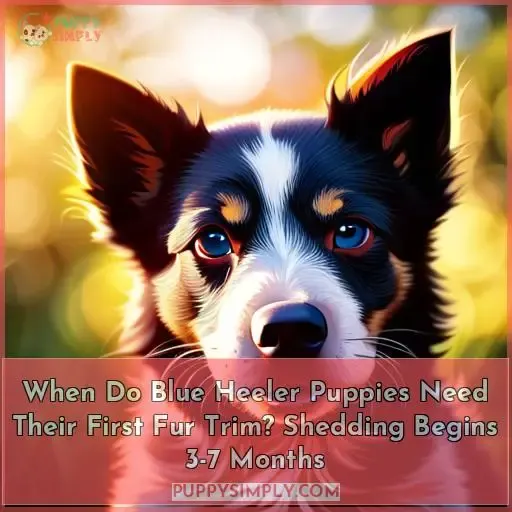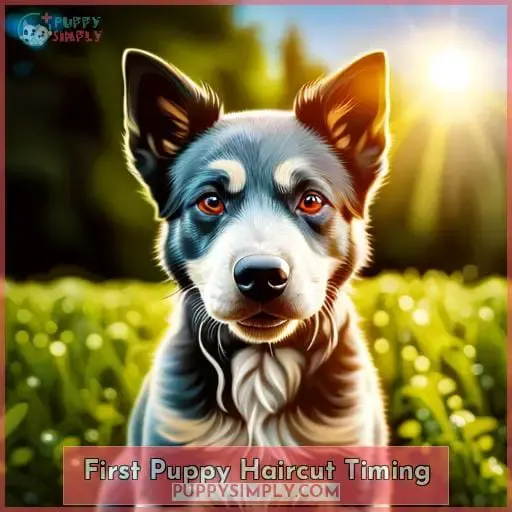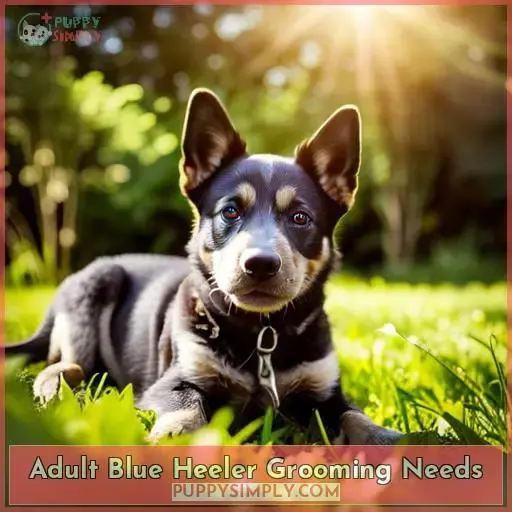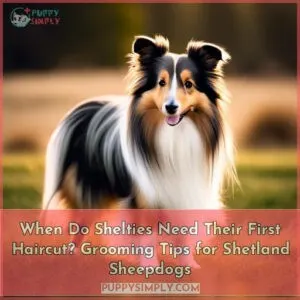This site is supported by our readers. We may earn a commission, at no cost to you, if you purchase through links.
 As you watch your rambunctious blue heeler pup grow into a headstrong adult, you’ll likely start noticing more fur around the house.
As you watch your rambunctious blue heeler pup grow into a headstrong adult, you’ll likely start noticing more fur around the house.
Around 3-7 months, your puppy’s soft coat begins shedding to make way for the adult fur.
Schedule your pup’s first professional grooming around 3-4 months to introduce important routines that support a healthy, handsome coat.
Table Of Contents
- Key Takeaways
- First Puppy Haircut Timing
- When the Puppy Coat Sheds
- Supporting Healthy Fur Growth
- Adult Blue Heeler Grooming Needs
- Frequently Asked Questions (FAQs)
- What kind of clippers work best for a Blue Heeler’s coat?
- How can I make sure my puppy stays calm and relaxed during grooming?
- When should I introduce brushing and handling exercises before the first haircut?
- How often should an adult Blue Heeler receive professional grooming services?
- What signs of skin irritation or allergies should I watch out for after grooming?
- Conclusion
Key Takeaways
- Ideal time for first puppy haircut is around 3-4 months old
- Start introducing grooming routines like bathing and brushing around 3-4 months old
- Puppy coat starts shedding around 3-7 months old, transitions over several years
- Groom regularly during coat transition to support healthy fur growth
First Puppy Haircut Timing
Around 3-4 months old is the ideal time to give your Blue Heeler puppy its first fur trim.
This initial haircut introduces important grooming routines that will become a regular part of your pup’s care.
Getting your puppy used to gentle brushing, bathing, nail clipping, and teeth brushing at a young age makes these activities less stressful for both of you later on.
Around 3-4 Months Old
By the time your Blue Heeler pup is 3 to 4 months old, it’s recommended to give him his first puppy haircut.
This first haircut celebration trains your puppy that grooming is normal and creates opportunities to teach good behavior.
Although their puppy fur coat looks cute, grooming prepares pups for the fur transition challenges ahead.
A professional groomer can advise you on starting a routine to support your puppy’s coat care and eventual adult grooming needs.
Introduces Grooming Routines
Giving your Blue Heeler puppy its first haircut around 3-4 months old starts establishing grooming routines.
Introducing grooming techniques like bathing, nail clipping, and brushing teaches good habits.
Handling your puppy gently, speaking softly, and giving treats during grooming makes it a positive experience.
Establishing these routines early prevents fear and discomfort later by familiarizing your puppy with grooming.
Consistent, patient grooming strengthens your bond while keeping your Blue Heeler’s coat healthy.
When the Puppy Coat Sheds
Around 3 to 7 months old, your Blue Heeler puppy will begin shedding its soft puppy fur.
This shedding process can last up to 5 years as the puppy coat is gradually replaced by adult fur.
During this time, you’ll notice patches and tufts of fur falling out irregularly before the new adult coat grows in.
Starts Around 3-7 Months Old
Around 3 to 7 months old, you’ll notice your Blue Heeler puppy starting to shed its puppy fur coat.
This fur transition lasts 2 months to 1.5 years as the pup loses fur irregularly in patches and clumps.
To support healthy fur growth:
- Groom gently and regularly during transition
- Keep pup’s fur and skin clean
- Use a soft brush and natural shampoo
- Strengthen your puppy bonding
Through this process, you’ll establish essential grooming routines for your Blue Heeler’s adult maintenance needs.
Lasts Up to 1.5 Years
The puppy coat shedding process can last up to 1.5 years as your Blue Heeler transitions from soft puppy fur to coarser adult fur.
You’ll notice the fur coming out in irregular patches and clumps before the new adult coat grows in fully.
This uneven and prolonged shedding can pose grooming challenges, but working through it together strengthens your bond.
Genetic factors influence variations in the coat color change timeline across Blue Heeler litters.
Consistent gentle brushing keeps their skin and growing fur healthy during this phase.
Supporting Healthy Fur Growth
When your Blue Heeler puppy begins shedding around 3-7 months old, it’s important to groom them regularly during this transition period.
Gently brushing and bathing keeps their skin and fur clean while the new adult coat grows in, promoting healthy fur and skin.
Being consistent with positive, gentle grooming will also strengthen your bond with your pup.
Groom Regularly During Transition
Through regular grooming during this coat transition, you’re promoting healthy new fur growth and keeping their skin and remaining puppy fur clean.
Gentle brushing stimulates blood flow to hair follicles, distributing natural oils.
This routine handling accrues big dividends later by acclimating your pup to maintenance required for their adult coat.
Keeps Fur and Skin Clean
Grooming your pup regularly while their coat transitions keeps their fur and skin clean, which supports healthy growth of their adult coat.
Gentle but thorough brushing removes loose hairs and dirt while distributing natural oils.
This prevents matting and skin irritation during heavy shedding stages.
Establishing positive grooming routines now makes coat care easier long-term by acclimating your blue heeler puppy to being handled.
Adult Blue Heeler Grooming Needs
As an adult, your Blue Heeler’s grooming needs will depend on its lifestyle.
This energetic breed requires brushing about 1-2 times per week to control shedding and keep their short to medium-length coats clean and healthy.
More time spent outdoors means more dirt and debris ending up in their fur, so more frequent baths may be necessary, up to once a week.
Depends on Lifestyle
You’ll need to groom an adult Blue Heeler regularly depending on its lifestyle.
More time spent outdoors means more dirt, knots, and debris to brush out.
Working dogs may need baths up to once a week to stay clean and healthy.
Less active pets require less grooming, but still need weekly brushings to control shedding.
Requires Weekly Brushing
Blue heelers generally require weekly brushing to help control the level of fur shed in their environment.
As working dogs, their coats benefit from routine care to remain healthy and minimize shedding mess.
Establishing a weekly brushing routine while young maintains their coat, promoting fur renewal and limiting loose hairs in the home.
This consistent grooming rhythm supports cleanliness and Blue Heeler well-being.
Frequently Asked Questions (FAQs)
What kind of clippers work best for a Blue Heeler’s coat?
Andis UltraEdge or Oster A5 two-speed clippers with a #10 blade work well for Blue Heelers’ short, dense coats.
Go slowly, praise your pup, and use a guard comb if needed to prevent nicks until you and your dog get comfortable with the process.
Regular brushing between clippings reduces shedding mess.
How can I make sure my puppy stays calm and relaxed during grooming?
Stay calm yourself.
Keep sessions short and positive.
Reward good behavior with treats and praise.
Handle your puppy gently.
Speak softly.
Don’t force anything.
End on a good note so they associate grooming with positive experiences.
When should I introduce brushing and handling exercises before the first haircut?
Introduce brushing and handling before 12 weeks old, so your puppy learns to accept and even enjoy the sensation.
Start slow with short, gentle sessions to build trust without overwhelming.
Be patient and praise calm behavior, creating positive associations well in advance of any haircut.
How often should an adult Blue Heeler receive professional grooming services?
Based on the background provided, an adult Blue Heeler would benefit from professional grooming about every 6-8 weeks.
This allows for:
- Regular nail trims
- Ear cleaning
- Shedding control
- Overall coat health maintenance
Establishing a routine can make the process smooth for both you and your Heeler.
What signs of skin irritation or allergies should I watch out for after grooming?
Watch for red, inflamed skin and excessive biting, licking, or scratching after grooming.
These may indicate an allergic reaction or skin irritation from products used.
Gently wash with a mild shampoo if this occurs.
Conclusion
As your eager pup sheds soft fur for his adult coat, refer back to the routines laid in those early months.
Regular brushing keeps his coat tidy amidst the flurry of blue tufts around the house.
Schedule professional trims as his lifestyle demands – whether herding cattle or napping on the couch, his fur requires weekly tending.
Walk with him through this transition, and you’ll continue reaping the rewards of your devoted blue heeler’s faithful companionship.










